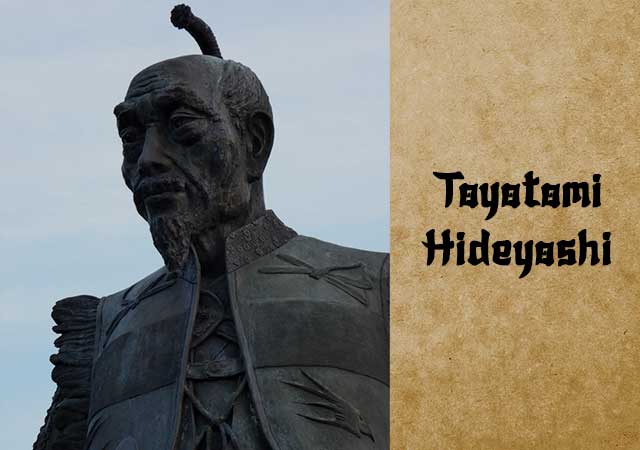
Toyotomi Hideyoshi, the second of the Three Great Unifiers of Japan, commenced his journey as a foot-soldier and ascended through the ranks to become a samurai, military leader, statesman, and eventually the ruler of Japan.
Born in 1536 in Nakamura village (now part of Nagoya City, Aichi Prefecture), Hideyoshi faced adversity from a young age. His father passed away shortly after his birth, and his mother remarried a low-ranking samurai who treated him harshly. Despite being sent to a nearby temple to train as a priest, Hideyoshi fled at the age of 15 to join Matsushita Yukitsuna's army as an ashigaru foot soldier. In 1558, he received funds to purchase armor for his master but instead bought equipment for himself, showcasing his independent spirit and resourcefulness. Back in Owari (Aichi Prefecture), he joined Oda Nobunaga's service as a sandal carrier.
Hideyoshi's ingenuity and dedication caught Nobunaga's attention. He participated in key battles such as Okehazama, Inabayama, and Anegawa, distinguishing himself as a capable warrior. When news of Nobunaga's assassination reached him during the siege of Takamatsu Castle, Hideyoshi swiftly intervened, negotiating peace and turning his forces against the traitorous Akechi Mitsuhide. He defeated Mitsuhide's army at Yamazaki and returned to Kiyosu Castle to ensure the continuity of the Oda clan's leadership.
As he governed on behalf of Nobunaga's infant grandson, Samboshi, Hideyoshi faced challenges from within the clan, notably from Nobutaka and Shibata Katsuie. However, he skillfully navigated these conflicts, consolidating his power through strategic alliances and military victories. His campaigns extended across southern Japan, standardizing currency and implementing social reforms to maintain stability.
Hideyoshi's ambitions extended beyond Japan's borders, leading to two significant campaigns in Korea. Upon his return, he found political dynamics shifting. Despite appointing regents to oversee his son Hideyori's rule, internal strife emerged, ultimately leading to civil war.
He passed away in 1598 at Fushimi Castle, leaving behind a legacy of unification and governance. Despite his modest physical stature and alleged birth defects, Hideyoshi's intellect and strategic prowess propelled him from humble beginnings to a revered figure in Japanese history.
See also
-
Yamagata Masakage

Masakage was one of Takeda Shingen’s most loyal and capable commanders. He was included in the famous list of the “Twenty-Four Generals of Takeda Shingen” and also belonged to the inner circle of four especially trusted warlords known as the Shitennō.
-
Yagyu Munenori

Yagyū Munenori began his service under Tokugawa Ieyasu while his father, Yagyū Muneyoshi, was still at his side. In 1600, Munenori took part in the decisive Battle of Sekigahara. As early as 1601, he was appointed a kenjutsu instructor to Tokugawa Hidetada, Ieyasu’s son, who later became the second shogun of the Tokugawa clan.
-
Yagyu Muneyoshi

A samurai from Yamato Province, he was born into a family that had been defeated in its struggle against the Tsutsui clan. Muneyoshi first took part in battle at the age of sixteen. Due to circumstances beyond his control, he was forced to enter the service of the Tsutsui house and later served Miyoshi Tōkei. He subsequently came under the command of Matsunaga Hisahide and in time became a vassal first of Oda and later of Toyotomi.
-
Endo Naozune

Naozune served under Azai Nagamasa and was one of the clan’s leading vassals, renowned for his bravery and determination. He accompanied Nagamasa during his first meeting with Oda Nobunaga and at that time asked for permission to kill Nobunaga, fearing him as an extremely dangerous man; however, Nagamasa did not grant this request.
-
Hosokawa Sumimoto

Sumimoto came from the Hosokawa clan: he was the biological son of Hosokawa Yoshiharu and at the same time the adopted son of Hosokawa Masamoto, the heir of Hosokawa Katsumoto, one of the principal instigators of the Ōnin War. Masamoto was homosexual, never married, and had no children of his own. At first he adopted Sumiyuki, a scion of the aristocratic Kujō family, but this choice provoked dissatisfaction and sharp criticism from the senior vassals of the Hosokawa house. As a result, Masamoto changed his decision and proclaimed Sumimoto as his heir, a representative of a collateral branch of the Hosokawa clan that had long been based in Awa Province on the island of Shikoku. Almost immediately after this, the boy became entangled in a complex and bitter web of political intrigue.
-
Honda Masanobu

Masanobu initially belonged to the retinue of Tokugawa Ieyasu, but later entered the service of Sakai Shōgen, a daimyo and priest from Ueno. This shift automatically made him an enemy of Ieyasu, who was engaged in conflict with the Ikkō-ikki movement in Mikawa Province. After the Ikkō-ikki were defeated in 1564, Masanobu was forced to flee, but in time he returned and once again entered Ieyasu’s service. He did not gain fame as a military commander due to a wound sustained in his youth; nevertheless, over the following fifty years he consistently remained loyal to Ieyasu.
-
Honda Masazumi

Masazumi was the eldest son of Honda Masanobu. From a young age, he served Tokugawa Ieyasu alongside his father, taking part in the affairs of the Tokugawa house and gradually gaining experience in both military and administrative matters. At the decisive Battle of Sekigahara in 1600, Masazumi was part of the core Tokugawa forces, a clear sign of the high level of trust Ieyasu placed in him. After the campaign ended, he was given a highly sensitive assignment—serving in the guard of the defeated Ishida Mitsunari, one of Tokugawa’s principal enemies—an obligation that required exceptional reliability and caution.
-
Hojo Shigetoki

Hōjō Shigetoki, the third son of Hōjō Yoshitoki, was still very young—only five years old—when his grandfather Tokimasa became the first member of the Hōjō clan to assume the position of shogunal regent.

